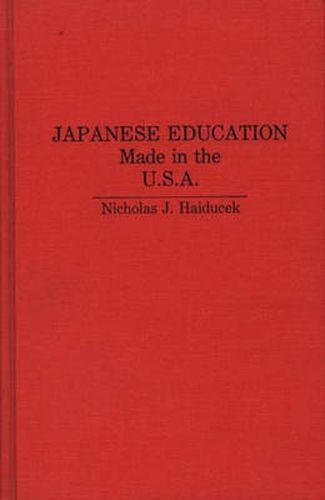Readings Newsletter
Become a Readings Member to make your shopping experience even easier.
Sign in or sign up for free!
You’re not far away from qualifying for FREE standard shipping within Australia
You’ve qualified for FREE standard shipping within Australia
The cart is loading…






The Japanese educational system has become an object of growing dissatisfaction among Japanese students and parents, due to its alleged suppression of intellectual creativity and its elitist examination process, and some Japanese educators are looking at the American system of higher education as a model of a viable alternative. According to Nicholas J. Haiducek, although the current efforts to develop branch schools of American colleges and universities in Japan are consistent with Japan’s penchant for borrowing and adapting information and technology, Japanese and American expectations concerning the goals of these endeavours differ greatly and thereby constitute significant obstacles to their success. By outlining the historical facts and the ideological motivations that define the Japanese educational climate and the American perspective, this work aims to increase awareness of the conflicting purposes at work and tries to stimulate informed communication between the two countries. The study examines America’s current educational presence in Japan by placing it within the historical framework of previous Japanese efforts to accumulate knowledge. The analysis then proceeds to discuss Japanese and American cross-purposes within the Japanese educational system, demonstrating why certain programs are not feasible in Japan and emphasizing the necessity for American programme developers to accurately evaluate the nature of Japan’s educational needs. The success of joint Japanese and American initiatives through the development of more effective programmes seems within reach. The study concludes with a look at the economic feasibility of these ventures for both countries and the humanitarian implications of such international co-operation.
$9.00 standard shipping within Australia
FREE standard shipping within Australia for orders over $100.00
Express & International shipping calculated at checkout
The Japanese educational system has become an object of growing dissatisfaction among Japanese students and parents, due to its alleged suppression of intellectual creativity and its elitist examination process, and some Japanese educators are looking at the American system of higher education as a model of a viable alternative. According to Nicholas J. Haiducek, although the current efforts to develop branch schools of American colleges and universities in Japan are consistent with Japan’s penchant for borrowing and adapting information and technology, Japanese and American expectations concerning the goals of these endeavours differ greatly and thereby constitute significant obstacles to their success. By outlining the historical facts and the ideological motivations that define the Japanese educational climate and the American perspective, this work aims to increase awareness of the conflicting purposes at work and tries to stimulate informed communication between the two countries. The study examines America’s current educational presence in Japan by placing it within the historical framework of previous Japanese efforts to accumulate knowledge. The analysis then proceeds to discuss Japanese and American cross-purposes within the Japanese educational system, demonstrating why certain programs are not feasible in Japan and emphasizing the necessity for American programme developers to accurately evaluate the nature of Japan’s educational needs. The success of joint Japanese and American initiatives through the development of more effective programmes seems within reach. The study concludes with a look at the economic feasibility of these ventures for both countries and the humanitarian implications of such international co-operation.